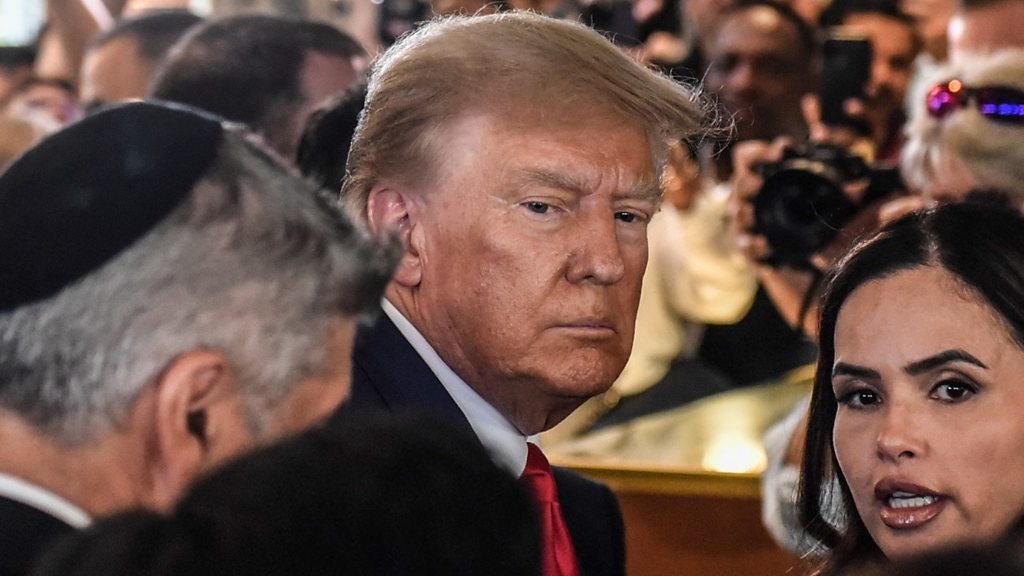Stony-faced in a blue suit and red tie, Donald Trump sat flanked by defence lawyers in a courtroom to face criminal charges, for the second time since leaving office.
The former president listened with a slight frown while prosecutors accused him of improperly possessing and concealing classified documents. It is the first time a former president has faced federal criminal charges.
There were no cameras, phones, or laptops allowed inside the Miami courthouse, and no photos were taken of Mr Trump’s arraignment.
Just a few moments before, US Marshals had processed Mr Trump like any other defendant, taking his fingerprints, date of birth, and address. No mugshot was taken, however. Mr Trump was so famous, officials said, that they did not need an additional photo.
The former president, known for his bombastic oratorical style, did not address the court once during his arraignment, even to enter a plea.
“We most certainly enter a plea of not guilty,” one of his attorneys, Todd Blanche, declared on his behalf.
At the same table as Mr Trump was Waltine Nauta, the personal aide that federal prosecutors have charged as a co-conspirator. The two, who had travelled to court together, did not appear to interact once inside the courtroom.
On the other side of the aisle, in the second row, sat Jack Smith, the Justice Department special counsel who just days ago unveiled the bombshell charges that Mr Trump had hoarded top-secret documents at his Mar-a-Lago estate.
He too said nothing, allowing lawyer David Harbach to take the lead arguing the government’s case.
Despite the spectacle, the room was stifled by silence, the whir of the air-conditioner the only sound until the judge arrived at 14:55 local time.
Judge Jonathan Goodman began the proceedings, presiding efficiently and firmly.
The arraignment hearing served two main purposes: to have defendants enter their pleas, and to have the judge set conditions of their bond.
The most significant action Mr Trump took on Tuesday was signing his bond agreement. A court employee passed the document to one of Mr Trump’s lawyers, who then provided it to the former president.
Mr Trump read it quickly, with his lawyers reading over his shoulder.
With a firm stroke of his pen, he signed the documents mandating the terms of his release.
A debate over the bond
Mr Trump and Mr Nauta received what was known as a “personal surety bond”. Judge Goodman released both Mr Trump and Mr Nauta without any restrictions on their travel, nor did they have to surrender their passports or pay a monetary bond.
The judge initially said Mr Trump would be forbidden from contacting a number of witnesses that was due to be provided by government prosecutors. Although that list has not yet been drawn up, Mr Trump’s legal team argued that many potential witnesses were likely to be Mr Trump’s employees or colleagues, and it would be “impossible” for him to not contact them at all.
In the end, Judge Goodman attempted to accommodate Mr Trump, deciding he would only be forbidden from speaking to these as yet unknown witnesses about the facts of the case. If the list of witnesses he could not speak to seemed “unwieldy”, Mr Goodman said, Mr Trump could appeal it.
Mr Nauta did not enter a plea today, as his lawyer was not currently authorised to practice in the Southern District of Florida.
Instead, he was released on bond and his own arraignment was postponed to 27 June.
An efficient hearing
Though historically significant, the proceedings moved relatively quickly, lasting just 50 minutes.
“My involvement in the case ends just about now,” Judge Goodman declared at 15:45 local time, punctuating the statement with a tap of his watch. Another judge is expected to oversee future proceedings.
As everyone in the court stood, Mr Trump was whisked out a side door by his security detail and into a waiting motorcade.
A few moments after Mr Trump left, Mr Smith, the special prosecutor, strode out of the courtroom without saying a word.
Source: BBC News


